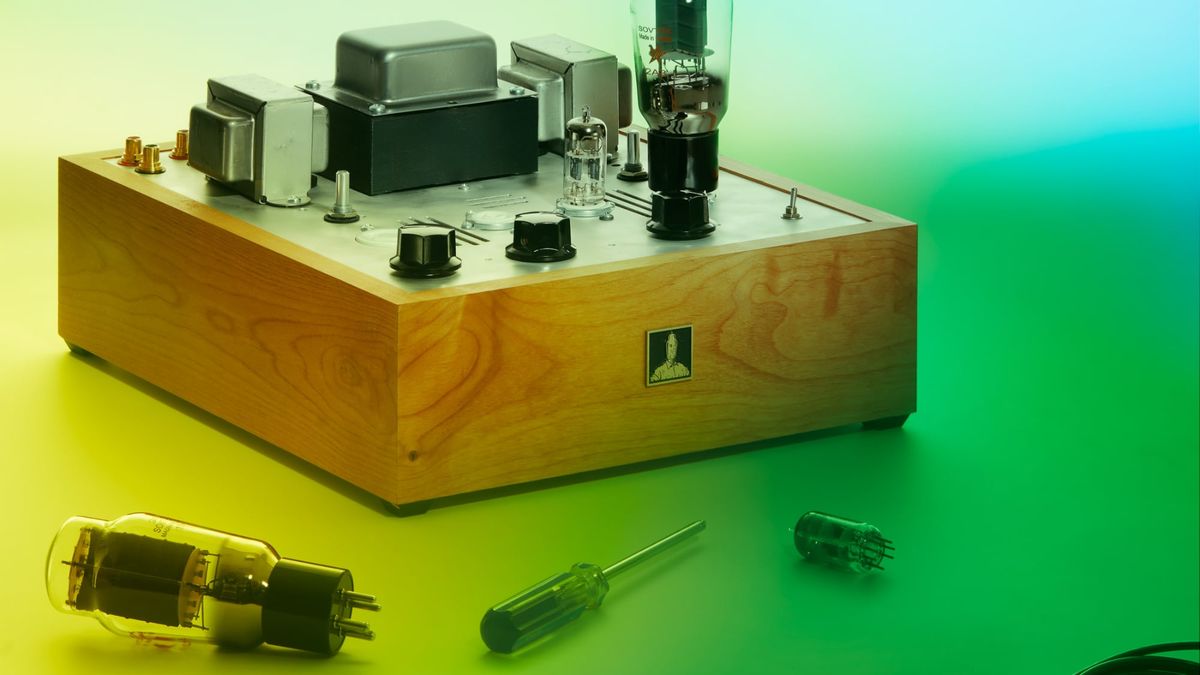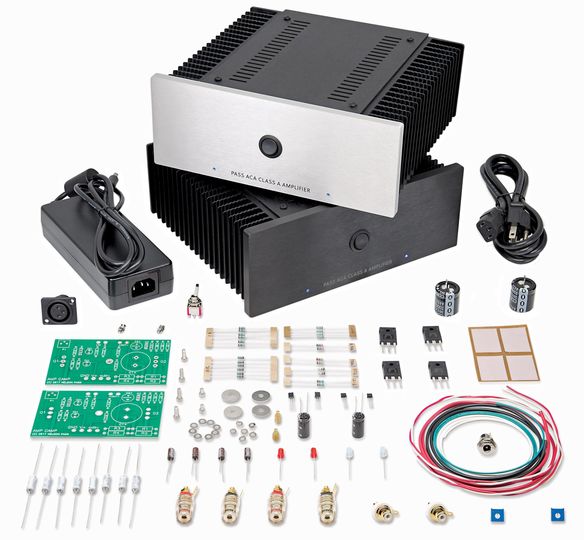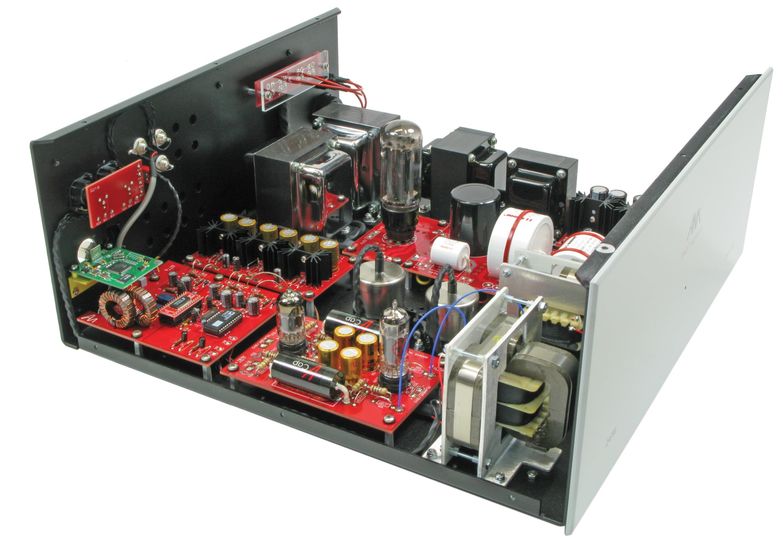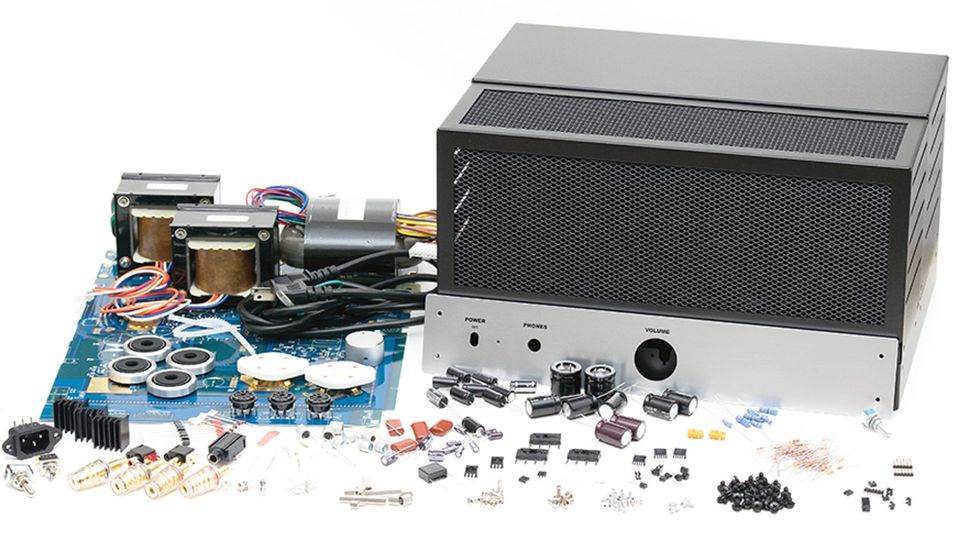This weekend, why not build a stereo from scratch?
The old-fashioned appeal of audio kits never goes away – especially during a pandemic.

Brad Breedlove never considered himself an audiophile. The project manager for an Indianapolis-area industrial piping company has been collecting vinyl for about five years, and the records in frequent rotation on his midrange Audio-Technica turntable include the well-worn now-classics that belonged to his parents when he was growing up.
It’s a good stereo system - but not obsessively so - that includes SVS Ultra Bookshelf speakers and an SVS SB 4000 subwoofer powered by a Schiit Vidar amp.
In September, however, Breedlove took a step into the deeper waters of the sonically serious and ordered a US$369 Reduction 1.1 phono preamplifier from Bottlehead, an audio kit maker in Washington state.
When it arrived, the box contained slabs of unfinished alder wood, carefully packed circuit boards, vacuum tubes, and bags full of capacitors and resistors.
Before he could turn on his preamp, he would have to put it together.
In the golden age of hi-fi in the 1950s and ’60s, building your own stereo equipment was almost as common as buying it.
Entire magazines dedicated to the craft were full of black-and-white halftone depictions of Brylcreemed dads hunched over disemboweled sound systems from companies such as Heathkit and Dynaco, soldering irons in hand.
These days, it’s often the warm glow of vacuum tubes on Instagram – and a surfeit of time – that draws in people.
The warm inner (and outer) glow
Breedlove had some experience framing houses and building decks, but this was his first electronics project.
He borrowed a soldering iron from his brother, watched a few YouTube videos, and “just kind of figured it out,” he says. The project took about eight hours spread over two afternoons.
“The instructions were easy to follow,” he says, “and the first time I fired it up, it worked.”
He joins a growing number of enthusiasts who are building inaugural systems this year. Bottlehead’s founder, Dan Schmalle, saw a surge in orders that started in the spring, coinciding with lockdown measures to combat Covid-19.
“It was definitely a lot of first-timers,” he says. “It was guys who were saying, ‘Man, I’ve been thinking about this for three years, and here’s the opportunity.’"
"Of course, what they weren’t saying was ‘I also got that stimulus check, which is just about exactly what this kit costs.’ We saw right when this check started hitting, it was going into our bank.”
At Ottawa-based ANK, which specializes in high-end digital-to-analog converters (DACs), director Brian Smith had a similar experience
“In the summers we typically slow down on sales because people are not really thinking about projects, but this year, it just kept climbing,” he says.
That surge was reflected in the audio industry as a whole.
“While sales in tech over the past six months have been dominated by productivity-focused products like PCs,” says Ben Arnold, an analyst with NPD Group, “we’ve also seen growth in consumers’ investment in entertainment, of which audio is included."
U.S. sales in the audio category from March through August totaled US$5.62 billion, Arnold says, with “11% growth during what is normally a pretty sleepy sales time.”
This one time, at Amp Camp...
Even if build-your-own audiophile gear is a niche within a niche - Bottlehead sells a few thousand kits a year - it’s a decent-size one, says Jason Donald, who founded DIYAudio in 1999.
The site’s forums have more than a half-million members, he says, who contribute about a thousand posts a day. Much of the conversation revolves around tips for building and modifying gear bought from a related online store Donald began in 2009.
Components and kits can range from the US$1,950 Elekit TU-8600S 300B amp, suited to builders with a few projects under their belt, to a US$327 Amp Camp one, geared for novices and originally designed in 2012 by industry guru Nelson Pass.
The most recent allotment sold out quickly, and orders taken now won’t be fulfilled until January.

Pete Raho of Gowanus Audio in Brooklyn been teaching the DIY-curious to build Overnight Sensations speakers for the past two years.
Now that in-person workshops are few and far between, he’s rolling out a new strategy: For US$565, he’ll send all of the parts to build a pair of those bookshelf speakers. Included in the price is a loaner box of tools, with a return shipping label. (You can knock US$20 off if you have everything you need.)
Also included are 90 minutes of live Zoom or FaceTime instruction for tasks such as soldering the crossovers or applying veneer.
The new art of DIY
Clear directions and customer service are, arguably, more important for a happy outcome than the actual hardware. ANK recently hired a documentation specialist to improve the steps for its kits.
“The manuals have gotten so good over the last couple of years that we’re at a point now where I just don’t hear from people anymore,” Smith says.
Build times can range from a few hours to a few days, depending on the project’s complexity and the builder’s skill. Bottlehead’s forums are a source of support from both fellow builders and their products’ designers.
And if all else fails, the company will soon bring back a repair service that will “do what is needed to make it function to stock specifications.” ANK, where the initial outlay is often considerably higher, will do it free.
You could always let someone else do the building. ANK’s L5 DAC 5.1 Signature costs US$5,000 in kit form, but can be bought fully assembled for US$6,050.
Independent builders also hawk completed kits on EBay and Etsy, where Bottlehead’s bestseller, the US$430 Crack headphone amp (with the Speedball upgrade), can be purchased for US$725, no assembly required.
Of course, having someone else do the building is to completely miss the point, Raho says.
“We’re so devoid of authentic experiences. We’re going in that direction – it’s not getting any better,” he says.
“But I can take apart a tube amp and figure out how it works. I can take apart speakers and figure out how they work. It’s human scale. It really puts a smile on your face and lights you up. You cannot get that from a little Jambox, or whatever.”
That’s not to say that your commitment of money, sweat, and soldering is the only reason to love a piece of homebuilt audio gear. Much of it sounds genuinely great.
Old brands consider a new future
Steve Guttenberg, a writer and stalwart of the audiophile community with a substantial YouTube following, recently tested the Amp Camp amp and noted that “you don’t buy this amp if you’re a measurement geek” – a persnickety class of audiophile who quantifies every aspect of a piece of equipment’s ability to accurately reproduce a sound.
But, he says, it’s “definitely cut from the same sonic cloth” as Pass’s other revered designs, such as the US$4,000 First Watt J2 amplifier.
Guttenberg has also described Bottlehead’s Crack headphone amp as something that “sounds like it’s five times the price.”
One difference between the heyday of kit stereos and today is that back then, even Harman Kardon, Fisher, McIntosh, and other big-name manufacturers offered DIY options alongside finished pieces. The current surge of interest is causing at least one of those companies to consider reentering the market.
“We’re taking a serious look at it now,” says Charlie Randall, chief executive officer of McIntosh Laboratory Inc. Discussions are ongoing about how complex a project its kit would be.
“We would have to supply the circuit boards and then let the people basically do the mechanical assembly and wire connection,” he says. “That’s what we’re leaning toward.”
If there’s uncertainty about how difficult to make the kit, there’s little doubt about the enthusiasm an audio-kit release from the company would create.
Randall says that when he sent out an image of the original 1960 advertisement for the company’s first (and only) foray into DIY audio, the Mac-Kit 30 tube amplifier, to a group of 25 of McIntosh’s longtime dealers, he was deluged with responses of “You gotta do it!”
His new caption for the vintage ad? “Back by popular demand!”
This article is published under license from Bloomberg Media: the original article can be viewed here



Qantas - Qantas Frequent Flyer
27 Aug 2014
Total posts 40
Wow - reminds me of my uni days in the 70's.
One of my lecturers at Monash Elec Eng designed and built an incredible sound system of a valve amplifier that could direct drive (ie no step up transformers to introduce distortion) a pair of also home made electrostatic speakers at +/- 3500 Volts. The speakers were 2m high quarter cylinder about 600mm radius. This was the sort of sound system you build the house around. I have never heard anything like it since.
That inspired me to design and build my own amplifier and speakers, though I wimped and went solid state and conventional speaker boxes. Great fun though and once I sorted out the problems that amp lasted me for 20 years, and I still have the speakers in the garage.
Thanks Dr Greg C - what an inspiration.
QFF
19 Sep 2013
Total posts 204
Reminds me of the Mullard 3-3 and bookshelf speakers of the early 60s. Note the orientation of the speaker and power transformers In the photos - at right angles to minimise hum. And BTW, in Oz they are valves, not “tubes”.
23 Oct 2020
Total posts 1
That's far from a scratch build and is just assembly. 12 years ago I built my SE KT88 amp from only a schematic.
25 Oct 2020
Total posts 2
You had a schematic? Posh! That's not building from scratch. I only had an idea told to me by an audio engineer over a pint of ale. And I had to build it in the dark, while living in a hole in the ground.
04 Dec 2013
Total posts 154
Hole in the ground? Ale? Luxury! I built mine while drinking bleach and living in a shoebox in the middle of a road.
24 Oct 2020
Total posts 1
Retired audio engineer here. Been Chief Engineer of radio and tv stations, maintenance engineer for major tv networks, owned a stereo repair facility with factory authorizations from major manufactures, worked full time as regional tech support for major audio manufacturer. I am not selling anything and don't have an agenda.
You get the most bang for the buck by treating your listening room to limit resonances. Most rooms have huge peaks and valleys in the neighborhood of 20 to 30 db or more. You can check your room with a smart phone and a couple of apps to generate and measure sound at different frequencies. You can purchase sound absorbing panels online or make your own out of fiberglass, wood, and cloth.
The next weakest link are the speakers. The crossover networks in unpowered speakers do really bad things to frequency response and phase. When the phase is off your mid range speaker could be fighting the woofer and tweeter at cross over frequencies The more speakers in a cabinet the more distortion caused by the crossover network.
There are some really good powered monitor speakers out there are not too expensive. Good powered speakers have an amp for each speaker in a frequency range. They do the crossover at the input using op amps. This way they can get precise control frequency response and phase.
Everything else in the chain is up to personal taste. Keep in mind that no one can hear 1 db of frequency response or 1 percent of distortion unless they are A/B testing using pure sine waves.
Human hearing is very subjective and the brain actively processes what the ears are sending. Doing a test using a sweep generator and a microphone is the first step to objective improvement.
One more thing. MP3 can really do a number on music depending on the level of compression. CD quality does a really good job of matching or exceeding human hearing. Anything beyond that and you are not hearing it. High bits rates are most valuable for recording, where you can get more headroom and lower noise, if everything else in the chain is high quality. High bit rates give a larger margin for error, so you don't have to be monitoring each input as closely.
Happy listening!
24 Oct 2020
Total posts 1
This is a waste of time unless you're doing it for the act of building something yourself. If you want to DIY a first rate audio system, consider class D modules from Icepower or Hypex or Pascal. You can get up to 500 clean WPC for less than about $800 if you get a good deal on the parts. Cases are cheap these days coming from China. I've built two Hypex based amps (NC500 and NC502MP - both super simple, the second of which is all on a single board LOL) which I sourced from people who had access to their commercial line (normally it's the NS400 sold via a DIY site) and two IcePower based amps (1200AS2 - just an amazing sounding piece of equipment and also all just one board, so very little work to do in assembling but you save some money).
09 May 2020
Total posts 565
I must be getting old.
No one here so far had made any reference to the smell of hot soldering iron or bagging those lead free solder or comparing the cheap and crappy irons vs really good ones...... all made in China
QFF
19 Sep 2013
Total posts 204
Ahh, the smell of hot smoky solder flux in the morning! All's good until you splash hot solder on a bare leg... Still fire up the solder iron occasionally. As one who used to fly in DC3s on business trips, life is still very good.
25 Oct 2020
Total posts 2
I spent months building an organ when I was 15. I remember it very well.
Hi Guest, join in the discussion on This weekend, why not build a stereo from scratch?